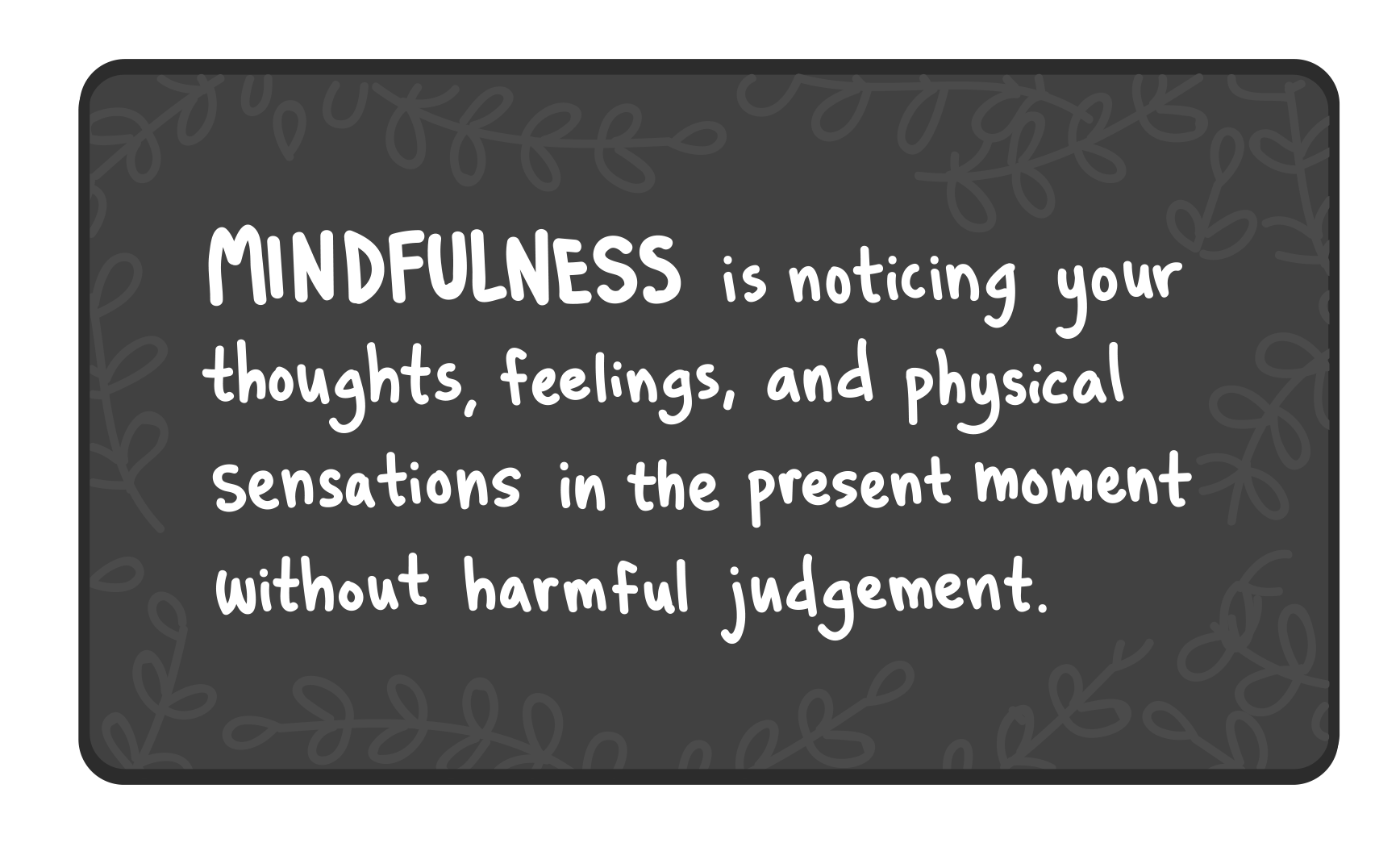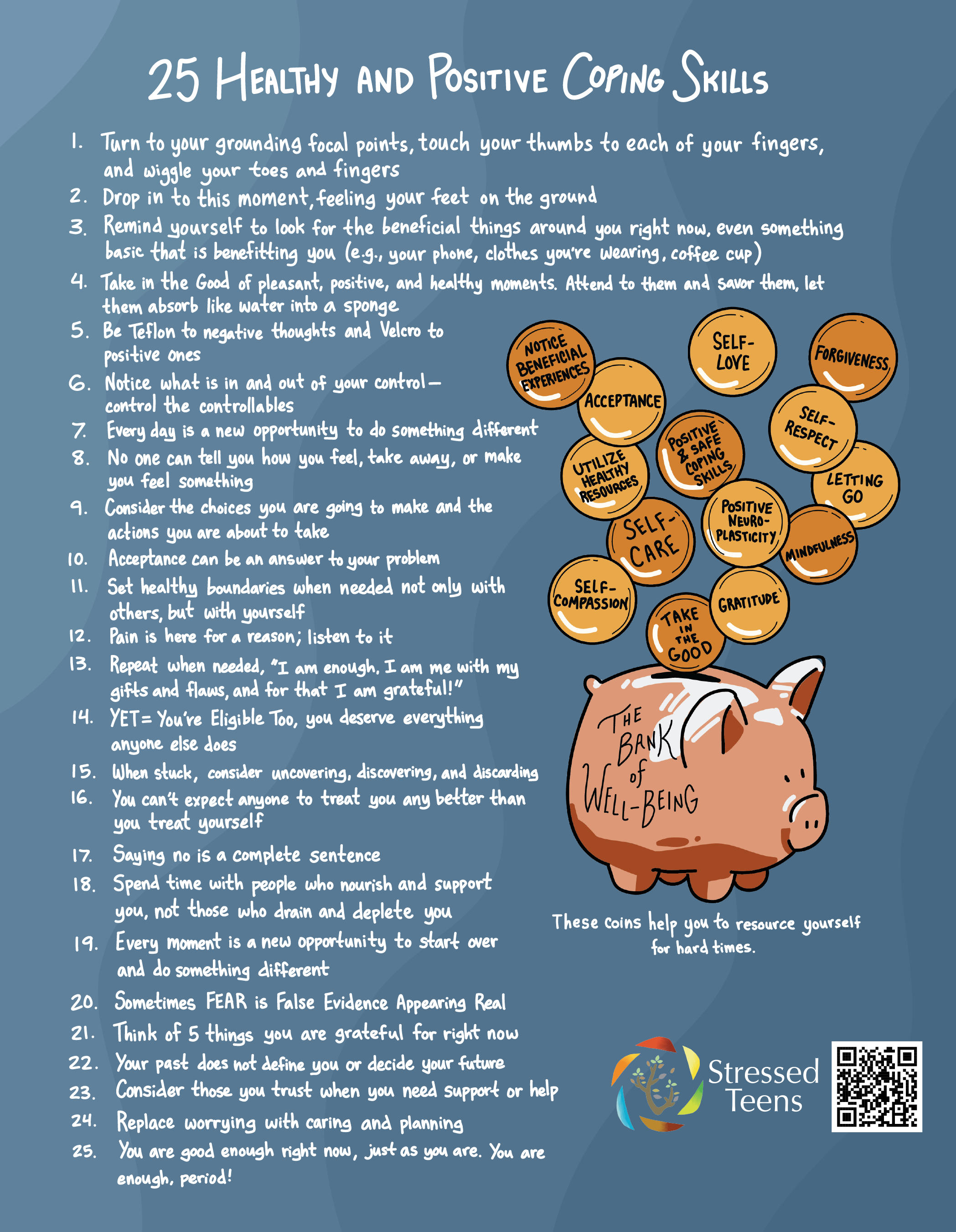Using mindfulness-based strategies and interventions teen’s functioning and quality of living often prospers. The mindfulness-based approach is advantageous with teens who need assistance with managing stressors. These are not limited to high-school demands, anxiety, depression, problems with relationships, difficulties with attention and focus.
Research on mindfulness interventions points to beneficial effects in emotional, physical, and academic domains. Mindfulness is increasingly integrated into academic and clinical settings involving adolescents and adults. Click here to review peer-reviewed journal articles on the efficacy of this program!
Taking in the good is taking care of yourself and feeling good in the moment. It is also about taking in, really noticing, and enjoying those self-care activities that you do. In this way, you are adding coins to your bank. Those coins have stored up and are like resource coins that will help you be better able to tolerate and manage whatever difficulties life throws your way—stressors, disappointments, and the like.
To Read More on Taking in the Good Click Here
6-min Excerpt on Mindfulness by Teen Adam Avin.
Mindfulness is a natural part of being human that involves present moment awareness and can be cultivated through both formal and informal practices.
Formal practice involves setting aside a specific amount of time to do a mindfulness practice.
These are the formal practices in MBSR-T:
· Mindfulness and the Five Senses
· Mindful Eating; Taking a Mindful Bite Practice
· Dropping-In Mindfulness Practice
· Body Scan Mindfulness Practice
· Sitting Mindfulness Practice
· Mindful Walking and Movement
· Yoga and/or Mindful Movement Practice
· Heartfulness Mindfulness Practice
Formal practices typically range anywhere from two to twenty minutes. In MBSR-T, most formal practices range from six to twelve minutes. The suggested times for most practices are listed in this guide.
Many formal practices can be made into informal practices. You can shorten a longer formal practice (e.g., a mindful bite rather than a mindful meal), or you can bring the practice to an activity you are already doing, rather than setting aside a specific amount of time to be mindful (e.g., walking to class instead of a formal mindful walking practice).
Informal practice involves bringing moment-to-moment awareness to anything you do in life, without exception. Simply zero in on knowing what you are doing as you are actually doing it.
In introducing the concept of informal practice, ask teens to see something for the first time even if they have already done or seen it a thousand times. Encourage them to integrate mindfulness into routine activities, interests, and hobbies. Discuss what adolescent-specific activities each person is involved in and how they can bring mindful attention and awareness to these activities. Review the integration and connection of noticing any and all of your five senses as a way to be practicing informally.
You can bring awareness to your senses when you eat from one bite to an entire meal. This week notice the foods you like and dislike of each meal you eat. You might even take notice of the foods you thought you really liked, but when you truly pay attention to the food and what it tastes like you might find you don’t like it at all. Check out Trot the Tortoise in this video is he mindfully eating the broccoli?
Is Trot eating broccoli mindfully or not?
1. To eat mindfully, get three pieces of some snack food (for example, nuts or raisins). Look at this food as something new you have never seen, even if you have eaten it a thousand times. Before you begin to eat, notice what is around you in the room, and what thoughts and feelings you have. Notice your breathing as you inhale and exhale a few times.
2. Set two pieces of the food aside, and take the third in your hand. Look at what you are about to eat. Think about how it got to you, from a field or store all the way to your hand. How do you feel knowing that you are going to eat? What do you notice in your mind?
3. Use your five senses. Notice what the piece looks like. Roll it around in your hand. What does it feel like? Hold it to your nose. What does it smell like? Place it near your ear. Can you hear anything? If you move it between your fingers, does it make a sound?
4. Feel the piece with your lips, and notice the taste it has left on them. Put it into your mouth without chewing it. What do you notice starting to take place in your mouth? Close your eyes, and let the piece roll around on your tongue. Put it between your teeth and feel it there without biting into it yet. Notice any saliva that is present. Pay attention to the change in its texture after it has been in your mouth for a bit.
5. Bite into the piece, noticing and tastes you experience. Slowly chew it for as long as you can. Right before you swallow, notice what it feels like to want to swallow this food. When you are ready, go ahead and swallow.
Notes: When you notice yourself getting distracted by your thoughts or feelings, take a moment to notice the distraction and refocus on the food. Repeat this process with the remaining two pieces of food.
Mindful Walking in Action
1. Choose a path about ten feet long; it can be anywhere you will be safe—inside or outside of your home or school, for example. The overall path doesn’t have to be long because you are not trying to get anywhere. It is about being mindful to the movement, not to how far you have gone. If you want to walk barefoot, take off your shoes.
2. For five to ten minutes, slowly walk back and forth on this path. Move your arms in whatever ways are comfortable to you. Start to experience what it is like to just walk and notice the sensations of actually walking. Notice what it feels like to lift your foot, shift, move, and place your foot; then start again with the other foot. You might want to attend to what causes your leg to lift or what sensations you have in your body. At the end of your path, turn around, paying as much attention to the process of turning as you did to walking.
3. If your mind wanders while you are walking, that’s normal; it’s what minds do. When a thought, a feeling, or something else distracts you in your surroundings, give yourself permission to stop walking. Take a moment to pay attention to whatever thought, feeling, or other thing distracted you, and then continue walking. What is important is the awareness that you got distracted and started walking again. Each time you engage in a walking mindfulness practice, try not to evaluate how you did. There is no good or bad way to do this practice.
This list of qualities are a foundation of being mindful. They encompass ways of being and living in this world. Here is a list of the Mindful Qualities in MBSR-T:
Acceptance
Curiosity
Compassion
Nonstriving
Authenticity
Not Knowing
Being versus Doing
Nonharmful Judging
Gentleness
Gratitude
Presence
Letting Go
Openness
Patience
Forgiveness
Care-Self and Other
Empathy
Respect
Trust
Generosity
Beginner’s Mind
Heartfulness/Loving-Kindness
Mindfulness is one way to manage stress. Mindfulness can help you to... Be Present, Stay Grounded, and Enhance Well-Being!









































